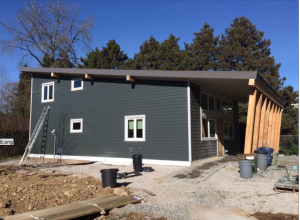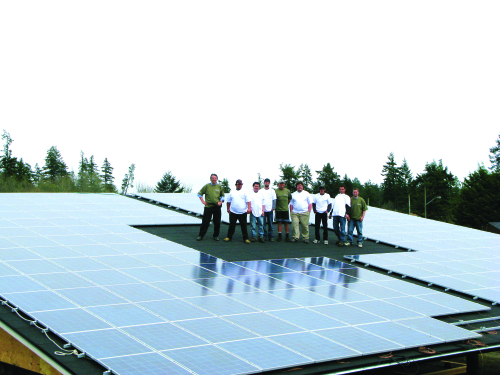Clean energy, better houses under scrutiny by nations
Fossil fuel-freeenergy and low-cost, low-carbon-footprint homes were just two topics under study at a Stz’uminus nation gathering on March 7. The workshop marked the end of a Naut’sa mawt Tribal Council NmTC project funded by BC’s clean energy business fund.
Participating nations included Halalt, Homalco, Stz’uminus and Tsawwassen. T’Sou-ke First Nation’s journey to becoming a ‘net-zero’ community was shared in a presentation by Andrew Moore while a new type of house construction was shared by Eli Enns, the chief administrator at Halalt.

The AYO house nearing completion at UBC. Photo courtesy of Chief James Delorme, Klahoose First Nation
Also on hand was John Lerner, the sustainable development advisor who coordinated the project that may be expanded to other nations soon. NmTC chief administrator Gary Reith said the next phase may include energy efficiency policies for housing that could be incorporated into the tribal council’s popular Housing Toolkit.
Moore said that the key to the T’Sou-ke solar success story was that “we engaged the whole community to develop a 100- year collective vision. Everyone was able to see how they, and every family, could be involved. “We showed young people that they can stand up and make change,” he said. “Many T’Sou-ke children have grown up with solar. It’s all they know.”
Among the benefits of T’Sou-ke’s solar success were reduced energy costs for all community members and energy autonomy for the nation. A side benefit was training solar installers who now can find work in a growing sector. Meanwhile, Eli Enns led a discussion about new kinds of house construction, as he shared information on the AYO ‘smart home’.
A demonstration model is near completion at the University of British Columbia’s Point Grey campus, as part of UBC’s Centre for Interactive Research on Sustainability.
The highly insulated house is built with magnesium oxide panels, is highly efficient in energy use and can be built for a relatively low cost. AYO representatives at the workshop said a $90-per-square-foot goal was possible.




